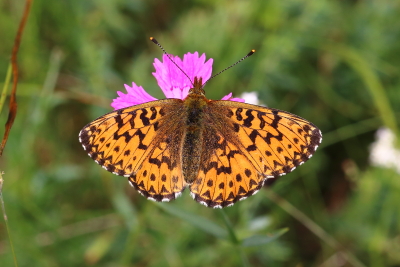















Titania's Fritillary (Boloria titania)
2024 photographs highlighted in yellow. Click on any photograph to go to an enlarged picture, or simply scroll down the page.
|
An attractive mountain fritillary with a minimum altitude range of around 800m. It is about the same size as the Pearl-bordered Fritillary (B. euphrosyne) and superficially similar. In France it only occurs in the Alpes, where it can often be quite common, in the Massif Centrale, and in one location in the Jura. The clearly solid and regular triangular or v-shaped uph submarginal marks identify titania from others of the same size; these marks are much narrower and more sagittate than for euphrosyne. Also, the titania underside is quite distinctive. |
There is a subspecies cypris, with brighter upperside ground colour and stronger black markings, and attractive purple-brown marbling on the unh. According to T&L cypris does not occur in France, but the evidence on this page tends to disagree. |
| ref | sex |
observations |
alt. m |
| 7878 | M |
a typical male. |
1750 |
| 26790 | M | a male, with quite dark markings and particularly heavy submarginal triangles and post-discal spots. The regularity of the triangles tends to suggest the possibility of euphrosyne, but on balance there is more evidence pointing toward titania. | 1700 |
| 30647 | M | a male, taking salts from the ground ("puddling"). The forewings are held back (this seems to often be the case for puddling specimens of any species) making the forewings look thinner. 30638 is the underside. | 2020 |
| 41531 | M | a crisply marked male in typical territorial pose. | 2020 |
| 48504 | M | a male, freshly emerged it appears. Even with the wings curled downward, the fresh bright colouring shows titania at its best. 48519 is the underside. | 1540 |
| 41994 | F | a female, usually significantly larger and duskier than the male. 41994 has pronouncedly sagittate submarginal chevrons. | 1400 |
| 3901 | F |
a slightly suffused female of the subspecies cypris, I believe. A female based on body shape and length. |
1800 |
| 51581 | F | a female, light orange ground colour, quite small post-discal spots on both wings, and very white chequered fringes. | 1540 |
| 38212 | F | a rather dusky female. | 2020 |
| 53002 | F | a fresh female, as indicated by the margins, but very dull in terms of colour and the suffusion around the markings. | 1380 |
| 48519 | M | a male of the cypris subspecies, a particularly purple example, probably the most extreme example I have ever seen. 48504 is the upperside. | 1540 |
| 30638 | M | a male, the underside of 30647. This is the nominate form of titania, which appears to be less common in the French Alpes than cypris illustrated by the two undersides on this page. The underside is particularly lightly marked, which does not seem to be the result of wear. | 2020 |
| 8223 | M |
the underside of the subspecies cypris, dark and intricately marked. I suspect it is a male based on the length of the body, just visible. |
1550 |
| 18811 | F |
a very dark female cypris underside, almost maroon. |
1250 |
| 35966 | pair | a mating pair, the higher butterfly (usually the female in mating pairs?) being of the subspecies cypris, and the lower being of the nominate titania. T&L indicates that cypris does not occur in France, which is clearly not the case here. What is particularly puzzling is that these are two subspecies of titania and they are mating. According to H&R (page 11): "By definition no two subspecies... ever fly together; but if and when their ranges meet they can, and often do, interbreed and produce intermediate forms." This seems to be contradictory - by definition they never fly together, but if they do... ?? We'll give them the benefit of the doubt in that when two subspecies meet at the edges of their respective ranges, they can interbreed. What is puzzling here is that both titania (the nominate species) and cypris are quite regularly encountered in the Alpes and their ranges seem to overlap considerably. Equally, when they have been seen, and this species is fairly common and widespread, they are always clearly of one subspecies or the other, without ever suggesting an intermediate form. They are on the larval hostplant, Bistort (Polygonum bistorta). | 2020 |
| 36021 | pair | the same pair as above, a close-up of the magnificently marked cypris subspecies. | 2020 |
26790_male_Alpes-Maritimes_09Jul11
30647_male_Hautes-Alpes_6Jul12
41531_male_Hautes-Alpes_15Jul16
3901_female_Alpes-de-Haute-Provence_15Aug06
38212_female_Hautes-Alpes_7Jul15
53002_female_Hautes-Alpes_13Jul24
30638_male_Hautes-Alpes_6Jul12
8223_male?_Vaud, Switzerland_19Jul07
18811_female_Haute-Savoie_17Jul09
35966_pair_Hautes-Alpes_13Jul14
36021_pair_Hautes-Alpes_13Jul14